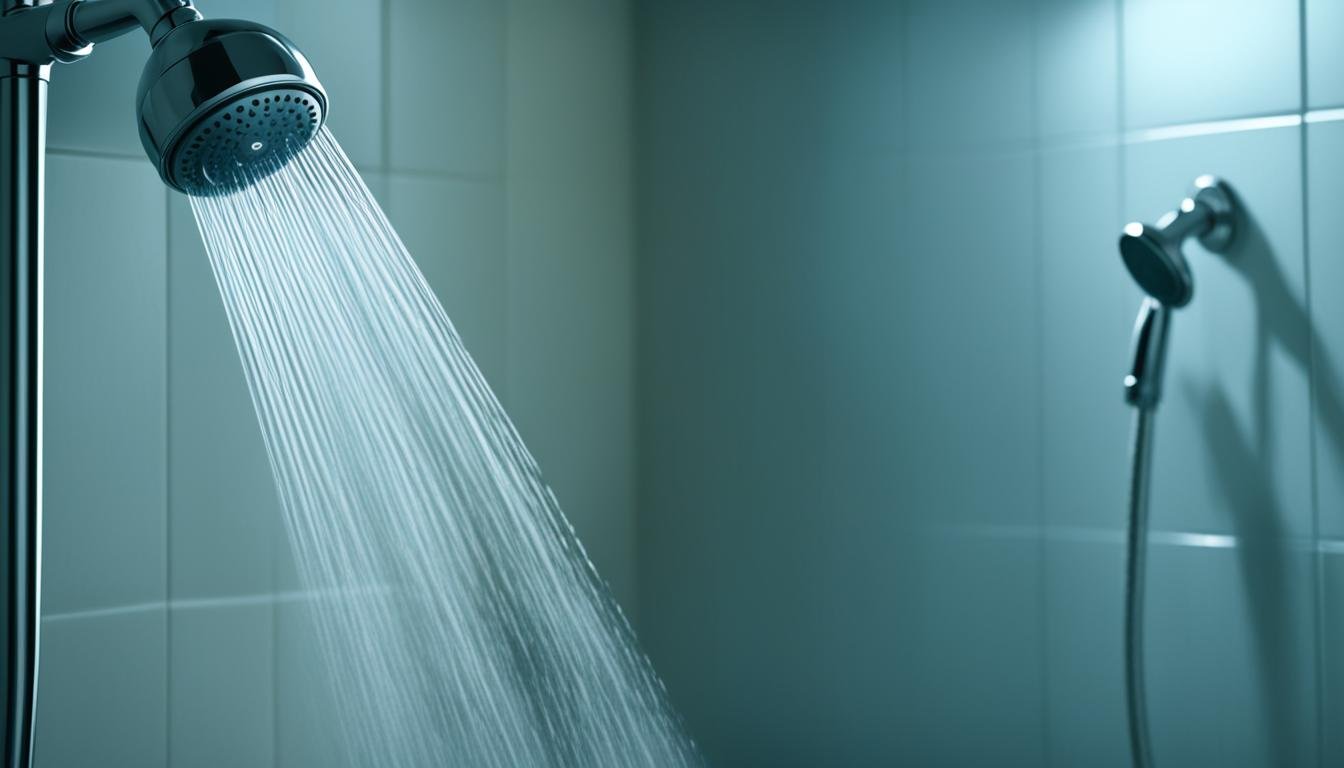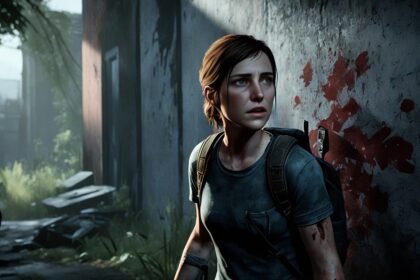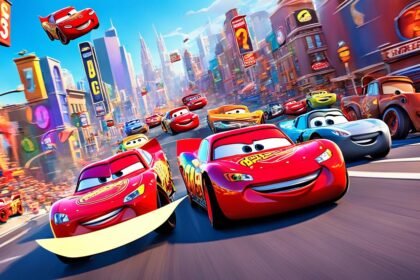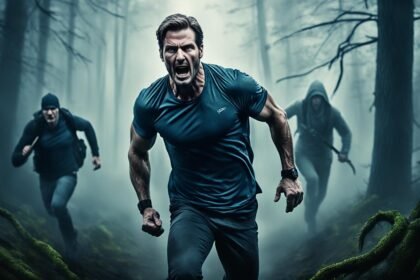Welcome to our tour of Psycho, Alfred Hitchcock’s iconic horror film. It was released in 1960, making it sixty years old this year. This movie remains a key part of film history, with Hitchcock’s skill in suspense and thrillers shining.
Psycho tells the story of Norman Bates, the mysterious caretaker of Bates Motel. Anthony Perkins plays Bates, engaging viewers with his eerie performance. The movie explores mental illness and shocks viewers with its view on society and the mind.
The iconic shower scene is at Psycho’s heart. It lasts 45 seconds but has over 90 cuts, showing Hitchcock’s unique style. With Marion Crane (played by Janet Leigh) as the focus, this scene changed the horror genre forever.
Psycho’s impact goes beyond its first showing, shaping future films. Hitchcock’s attention to detail and use of black and white cinematography stand out. The movie draws on the eeriness of a famous Edward Hopper painting, ‘House by the Railroad’.
Paramount Pictures initially didn’t back Psycho, but Hitchcock believed in it. So, he funded it himself. The movie, made on a small budget, earned over $50 million. This success proved its importance in film history.
Its success led to four Academy Award nominations and a place in the National Film Registry. Hitchcock skillfully adapted Robert Bloch’s novel for the screen. The film captivates audiences with its suspense and psychological layers.
Let’s explore the world of Psycho together. We’ll look at its creation, impact, and lasting influence on the horror genre.
Key Takeaways:
- Psycho is a timeless horror classic directed by Alfred Hitchcock.
- The film explores themes of mental illness and challenges societal norms.
- The iconic shower scene, composed of over 90 cuts, remains etched in cinematic history.
- Psycho’s influence extends beyond its release, inspiring generations of filmmakers.
- Hitchcock’s masterpiece continues to captivate audiences, cementing its place as a cinematic and narrative feat.
The Story of Psycho
In Alfred Hitchcock’s Psycho, we meet Norman Bates. He’s a young man who owns a motel. This guy has a strange relationship with his mother. The movie is full of twists that make us keep watching.
“A boy’s best friend is his mother.”
– Norman Bates
Norman Bates, played by Anthony Perkins, is the movie’s focus. He manages the Bates Motel. The story is all about his weird behavior connected to his mom. His issues lead to some creepy stuff that shows itself as the story goes on.
Norman seems quiet and nice at first. Then, we learn about his dark secrets and mental problems. The story gets deeper as we realize how messed up he is. This keeps us glued to the screen, wondering what will happen next.
The shower scene stands out in the movie, with Janet Leigh. Even though it’s short, it’s unforgettable. A lot of things make this scene great, like Hitchcock’s direction and the music. Together, they create a scene that scares and fascinates us at the same time.
Hitchcock’s Portrayal of a Troubled Mind
Hitchcock is a master at getting us to think about dark things. Norman Bates helps show us what a guilty and sick mind looks like. The movie explores deep, scary topics like who we are and what makes us feel bad.
The choice to film in black and white makes everything scarier. The dark and light differences are striking. This technique makes us feel tense, echoing the problems the characters face inside themselves.
Hitchcock’s great story makes Bloch’s book come alive. The acting, especially by Perkins, is incredible. Norman Bates is a complex and interesting character. This is why Psycho is still loved and gives us chills today.
Stay tuned for the next section as we delve deeper into Alfred Hitchcock’s vision and the techniques that made Psycho a groundbreaking and influential film.
Alfred Hitchcock’s Vision
Alfred Hitchcock is a big name in suspense and psychological stories. His work, like “Psycho,” aimed to blow people’s minds with new levels of suspense. This movie was a big step forward in captivating audiences with deep, thrilling stories.
In making “Psycho,” Hitchcock was really focused on detail. He planned each scene carefully to up the suspense. His goal was to shock everyone with a story that stuck in their minds for a long time.
Using black and white film was a bold move by Hitchcock. It made the movie look eerie and deepened the story’s psychological layer. This choice helped draw people into the strange world of Norman Bates.
Marion Crane’s change from good to bad is a standout moment in “Psycho.” Hitchcock cleverly used what she wore to show this change. It made her struggle and moral loss really hit home, making us question what’s real.
“Psycho” is still loved today, more than 50 years after it came out. People keep watching it and talking about it. It shows how powerful a movie can be.
He introduced the “MacGuffin” concept in “Psycho” too. The stolen money became this MacGuffin, driving the story and making us worry about the characters. It added a layer of suspense to the movie.
The shower scene is perhaps the most famous in the movie. Hitchcock used many camera angles and quick cuts to make it so intense. It’s a key moment in movie history that scared, and still scares, people.
“Vertigo” was another movie where Hitchcock blew everyone away. The way he used the camera in this film was new and emotional. It was groundbreaking in showing how someone’s gaze can affect us so much.
The spiral in “Vertigo” shows up a lot in the movie. It’s a symbol of getting stuck in repeating the same mistakes. This symbol deepens the movie, making us feel for the main character’s struggle.
In all his work, Hitchcock was a master at using the camera to make us feel certain ways. In “Psycho,” Norman Bates watching Marion is a key scene. It not only fits the psychological theme but shows Hitchcock’s skill at playing with our view.
The way Hitchcock used the camera in “Psycho” was genius. By choosing what to show and what not to, he kept people guessing and thrilled. It was a testament to his skill as a director.
The idea of the uncanny is very strong in “Psycho.” Norman Bates and Marion Crane mirror each other, making the movie feel strange and familiar. This theme runs deep, pushing us to question reality.
Hitchcock pushed the camera’s role to new places with “Psycho.” It brought a new way of blending reality and dream. This innovation made the film a masterpiece that changed how we see movies forever.
The Shower Scene
One of the most iconic moments in Psycho is when Marion Crane meets a gruesome end in the shower. The scene’s fame comes from its unique editing and chilling music. It shows Alfred Hitchcock’s skill in building tension and fear without showing everything.
The shower scene is a lesson in creating suspense in movies. Hitchcock carefully planned it, using many camera angles and edits. The entire process took a week to shoot. The fast cuts and close-ups make viewers feel the fear too.
Using black and white film and Hershey’s syrup for the blood was a brilliant move by Hitchcock. This choice added an artistic touch to the film. It also meant the scene was powerful without going too far for its time.
This scene is more than just famous; it’s changed how horror films are made. It’s remembered for its shock value, influencing not just movies but also TV and music.
Filmmakers and experts still look at the shower scene with awe. Its careful planning and effect on viewers show Hitchcock’s true genius. It proves the impact Psycho and Hitchcock have had on cinema.
Behind the Scenes
Let’s peek behind the scenes of the making of Psycho. This movie is a true classic, directed by Alfred Hitchcock. From planning to execution, every step was a precise work of art.
Alfred Hitchcock, a master of detail, was directly involved in creating every scene. He worked closely with his team to turn his ideas into thrilling visuals. The film, from its scary shower scene to the suspenseful ending, was a masterpiece because of his dedication.
The shower scene required a lot of work. It took a whole week to film and used 70 different camera angles. Hitchcock’s hard work paid off. The scene became one of the most memorable and scary moments in cinema history.
“The making of Psycho was groundbreaking. It changed how stories are told through film. Hitchcock’s grip on suspense and ability to scare the audience are clear. Everyone’s dedication led to a true thespian work of art.”
Bernard Herrmann’s music played a huge role in Psycho’s success. Hitchcock thought Herrmann’s music was so good, he doubled Herrmann’s pay. The music added an eerie feel to the movie, making it even more terrifying.
Although made on a small budget, Psycho stunned viewers around the globe. It’s proof that a movie’s success isn’t just about money. Hitchcock’s skill and creativity made Psycho a standout film.
Another brave move by Hitchcock in Psycho was showing a flushing toilet. It sounds simple now, but back then, it was a big deal in film. This scene pushed past old ideas and brought something new and daring to the screen.
“The hard work behind Psycho truly paid off. The flawless acting, clever editing, and bold new scenes made this film unforgettable.”
Images from the set of Psycho
Innovation and Secrets
Alfred Hitchcock made sure every detail was just right. In Psycho’s final scene, Simon Oakland, as Norman Bates, gave a perfect performance. This part was full of suspense and kept everyone on the edge of their seats.
The movie was almost stopped over the word “transvestite.” But, Hitchcock proved its scientific use and the movie kept going. This debate made Psycho even more interesting, diving into deep issues about mental health.
Hitchcock loved surprises, especially in his movies. He kept the twist of Psycho hidden from the actors. This kept the actors and the viewers in suspense until the very end. It made the movie even more shocking and memorable.
The Making of Psycho in Numbers
| IMDb Rating | Duration | User Reviews |
|---|---|---|
| 7.3/10 | 1 hour and 34 minutes | 467 |
Top Cast
- Alfred Hitchcock
- Peggy Robertson
- Clive Barker
- Joseph Stefano
- Patricia Hitchcock
- Hilton A. Green
- Janet Leigh
- Rita Riggs
- Paul Hirsch
Similar Documentaries
| Documentary Title | Rating |
|---|---|
| All About ‘the Birds’ | 7.7 |
| Beyond Doubt: The Making of Hitchcock’s Favorite Film | 6.6 |
| Rear Window’ Ethics: Remembering and Restoring a Hitchcock Classic | 7.5 |
| Obsessed with Vertigo | 6.9 |
| Plotting ‘Family Plot’ | 6.6 |
| The Story of ‘Frenzy’ | 6.7 |
| Rope Unleashed | 7.0 |
| Family Plot | 6.8 |
| Pure Cinema: Through the Eyes of the Master | 7.4 |
| Marnie | 7.1 |
Reception and Legacy
Psycho was a hit when it came out. People loved it and it made a lot of money. The film made over $50 million although it only cost about $800,000 to make. It greatly influenced the horror and movie industries.
“Psycho is a cinematic masterpiece that continues to captivate audiences with its psychological suspense and shocking twists.”
Alfred Hitchcock directed Psycho. It’s considered one of his best works. The film got four nominations at the Academy Awards, with Hitchcock himself nominated for Best Director.
Janet Leigh was also nominated for Best Supporting Actress. She played Marion Crane, the woman who meets a tragic fate in the famous shower scene.
In 1992, the Library of Congress honored Psycho for its cultural importance. This recognition shows how the movie has shaped film history.
Even years after its release, Psycho remains popular. It has several sequels and other adaptations. There’s a television show that continues the story, keeping the legacy alive.
Psycho Legacy Overview
| Release Year | Title | Format |
|---|---|---|
| 1960 | Psycho | Film |
| 1983 | Psycho II | Film |
| 1986 | Psycho III | Film |
| 1990 | Psycho IV: The Beginning | Film |
| 1998 | Psycho | Remake |
| 1987 | Bates Motel | Television series |
| 2013-2017 | Bates Motel | Television series |
The Psycho story goes beyond the first movie. The Psycho Legacy documentary looks at all the films. It talks with the people who made them, giving fans a deep look at the series.
The documentary first showed at the 2010 Screamfest Horror Film Festival. It was praised for honoring Alfred Hitchcock’s impact on horror movies.
The DVD has bonus content, like a talk with Anthony Perkins. He played Norman Bates, one of the most famous characters in horror. There are also extended interviews and behind-the-scenes looks.
Psycho continues to be cherished by fans. It shows the brilliance of Alfred Hitchcock and the lasting value of his work.
Psychological Themes
Pyscho, released in 1960, is a film that tackles deep psychological issues. It captures the audience with its story on mental illness and suspense. Due to director Alfred Hitchcock’s careful work, the movie has a lasting effect on viewers. It shows us a lot about the human mind.
The movie looks into Freud’s idea of the Oedipus complex, especially the part about sons and mothers. The character Norman Bates, played by Anthony Perkins, is at the center of this exploration. The film looks at his deep issues with his mother and how they lead to themes of pain and jealousy.
The love triangle between Marion Crane, her lover Sam, and Norman, shown on the poster, is a key part of the film. This symbolizes Norman’s deep internal struggles. It makes the story more complex and interesting, drawing in the audience.
Throughout the movie, birds are a key symbol. They represent Norman’s strange connection to his mother. This adds another layer to the characters’ relationships and makes the film even more suspenseful from a psychological angle.
Psycho raises big questions about mental health and what’s really in our minds. It makes viewers think long after the movie is over. Hitchcock’s detailed storytelling mixes perfectly with the complex psychology. This creates a movie that’s thrilling but also makes you think deeply.
Character Analysis – Norman Bates
Norman is the mysterious heart of the story. He’s dealing with very deep personal demons related to his mother. Anthony Perkins brings this character to life. His performance is memorable and leaves a strong impact on those who watch.
Even though the film is old, its psychological aspects still hit home with people. Hitchcock subtly weaves in themes that affect us emotionally. This makes the film timeless in its psychological suspense effect.
- Year of Production: 1960
- Director: Alfred Hitchcock
- Themes Explored: Freud’s Oedipus complex, male variant
- Symbolism: Triangular dynamic reflecting subconscious conflicts
- Significance of Birds: Illustrating Norman’s perception of his mother
- Character Analysis: Norman Bates’ unresolved Oedipal conflicts
- Viewership: Subtle influence of psychological themes
- Academic Recognition: Hitchcock’s pursuit of psychological understanding
Pyscho’s themes make it a true work of art. Hitchcock’s deep look into the human mind puts him up there as a brilliant director. His skill in blending suspense with rich psychology made Psycho a masterpiece.
Hitchcock’s Influence
Released in 1960, Psycho started a movie movement that still shapes cinema today. Alfred Hitchcock directed this iconic horror film, which was both shocking and thought-provoking for its time.
Many call Psycho a work of art and the beginning of slasher movies. Its bold style and unique storytelling have inspired a whole generation of filmmakers.
Alfred Hitchcock’s visual techniques are what made him the internationally recognized auteur that he is credited as today.” – Driscoll, 2014
Hitchcock was a master at creating suspense and fear in his films, as seen in Psycho. His impact is clear in movies that follow, like Dressed to Kill by Brian De Palma. De Palma has admitted that Hitchcock’s ideas greatly influenced his own.
There are many others who have paid homage to Psycho. For instance, The Silence of the Lambs makes direct nods to it. Even famed director Steven Spielberg has used Hitchcock’s suspense-building approaches in his films.
Psycho set the stage for the 1980s slasher film era. Films like Friday the 13th became popular thanks to Hitchcock’s initial work. This influence made Hitchcock a key figure in cinema history.
Surprisingly, some non-thriller films, like Barbie, include nods to Hitchcock. They do this through characters and scenes that reflect his distinctive visual style.
| Psycho Movie | Director | Year of Release |
|---|---|---|
| Psycho | Alfred Hitchcock | 1960 |
| Psycho II | N/A | 1983 |
| Dressed to Kill | Brian De Palma | 1980 |
Alfred Hitchcock’s impact through Psycho is vast. He influenced directors we know today, like De Palma, Spielberg, and even Tarantino. They’ve all learned from Hitchcock how to make movies filled with suspense.
Psycho’s Cultural Impact
When Psycho first came out, it changed how we think about horror movies. It made people realize that horror films can be so much more. The story was so thrilling and deep that it kept everyone on edge.
Alfred Hitchcock’s way of telling a scary story was so special. He really showed what horror movies could be. Because of Psycho, many filmmakers started making their own scary movies.
Hitchcock did something unique with Psycho’s showtimes. He made sure the movie was seen at specific times. This made seeing Psycho feel like a big, special occasion.
“Psycho was a game-changer in the horror genre, pushing the boundaries of what was considered acceptable, and inspiring generations of filmmakers to delve into the psychological and suspenseful aspects of horror.”
This new movie schedule made seeing Psycho a big deal. People wanted to be part of it. This idea changed how other movies were shown too.
But Psycho didn’t just change movies; it changed what people thought about movies too. The film had some shocking parts, like the shower scene. This scene is now famous for being so real and intense.
Psycho wasn’t just a big deal in the U.S. In the U.K., they said only adults could watch it. This shows how important and daring the film was.
The Legacy of Psycho
Psycho still matters a lot in horror movies today. It has inspired many filmmakers over the years. The film’s deep plot and unforgettable scenes continue to influence new movies.
| Impact | Details |
|---|---|
| Financial Success | Psycho made millions more than its cost, boosting Hitchcock’s fame. |
| Cinematic Inspiration | Many filmmakers have been inspired by it, leading to sequels and copycats. |
| Revolutionizing Movie-Watching Habits | Hitchcock’s unique showtimes for Psycho made movie-watching special. |
| Graphic and Memorable Scenes | The shower scene is one of the most violent and memorable in American movies. |
| International Cultural Impact | The U.K. gave it an adults-only rating, showing its global impact. |
Even today, Psycho is known as a horror masterpiece. Hitchcock’s work is still admired by many. It continues to inspire scary movies around the world.
Psycho’s Enduring Popularity
Pyscho is the iconic horror classic by Alfred Hitchcock. It’s still drawing in audiences worldwide, more than 60 years later. This movie has truly changed the film industry and is a crucial part of the horror genre. We’re here to find out why Psycho still grabs our attention and why it’s a must-see for anyone who loves to be scared.
In 1960, Hitchcock made Psycho with only $800,000 after the hit movie, North by Northwest. Even with a small budget, it made over $32 million at the box office. This big success didn’t just bring in money, but it also became a major part of Hollywood history.
The impact of Psycho on horror movies is huge. It showed violence like never before and used unique editing. This changed how scary movies were created. Many future films tried to copy its suspense and deep look into the characters’ minds.
Psycho stays popular because it makes viewers feel scared in a way that lasts. Hitchcock’s careful direction, together with the famous shower scene, stands out as a masterclass in horror. The sound of screeching violins in that scene has become famous for inducing fear.
But that’s not all. Psycho also changed how we go to the movies. It started the idea of having set movie times, making going to the theater more special. This change increased how many tickets were sold and made the movie even more famous.
“Psycho is a groundbreaking cinematic achievement that continues to captivate audiences with its timeless storytelling and masterful direction. Its lasting impact on the horror genre and its influence on filmmakers make it a true classic in every sense of the word.”
At first, Psycho got mixed reviews, but now it’s seen as one of the best films ever. Even though it was nominated for four Oscars, it didn’t win any. Its power is shown by its place in top movie lists and how much experts still talk about it.
Psycho’s Enduring Popularity – By the Numbers
| Release Year | Budget | Box Office Gross | Academy Award Nominations |
|---|---|---|---|
| 1960 | $800,000 | $32 million | 4 |
Even with time, Psycho’s story and Hitchcock’s skill keep bringing in new fans. It shows that the film’s horror is still as effective today as it was back then.
If you haven’t watched Psycho, you should. Get ready for a movie that will scare you and make you think. It’s a classic horror that has made its mark in the world of films.
Conclusion
Psycho is a brilliant movie, showing Alfred Hitchcock’s incredible skills. It came out in 1960 and still grabs our attention with its exciting story, unique methods, and lasting fame.
This movie changed the horror genre and culture forever. It’s known for an unforgettable twist and its ending, which made people think. Fans often discuss and dissect it in a series called “Ending Explained.”
Alfred Hitchcock truly shines through his direction in Psycho. He uses suspense and clever ways to show places and important parts of the story. This stirs our feelings and thinking as we watch. Psycho also looks deep into deep Freudian ideas, like the Oedipus complex and the uncanny. It makes us think more about the human mind and its complexities.
Psycho is special for making us question our identity and why we watch stories. Its unique telling and the way it was made keeps it a favorite for horror and suspense lovers. It is a must-see that remains in movie history and in our hearts all over the world.
FAQ
What is Psycho?
Psycho is a classic horror movie by Alfred Hitchcock. It’s known for its suspense and psychological aspects.
Who directed Psycho?
Alfred Hitchcock was the director. His unique vision shines through in this film.
What are the main themes of Psycho?
Psycho looks into mental illness. It also shows a disturbing mother-son relationship through Norman Bates.
What is the shower scene in Psycho known for?
The shower scene stands out. It used innovative editing and music to create fear without showing much violence.
How was Psycho received by audiences and critics?
It was loved by both critics and viewers. Today, it’s seen as one of the best films ever made.
What impact did Psycho have on the horror genre?
It changed how we see horror movies. Its impact is seen in films made since then.
What are some of the psychological themes explored in Psycho?
Psycho looks at mental illness. It also asks about what makes us sane and the nature of our minds.
How did Alfred Hitchcock’s vision shape Psycho?
Hitchcock carefully created each shot. His methods in Psycho are still studied today for building tension and suspense.
What is the cultural impact of Psycho?
It brought in new approaches to horror. Psycho opened the door for psychological, suspenseful films.
Why does Psycho continue to be popular?
It’s loved for its timeless story and Hitchcock’s great direction. It has a huge impact on films and culture.








